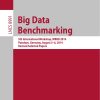Electrical Energy Conversion and Transport 2nd edition by George Karady, Keith Holbert 1118498062 9781118498064
$70.00 Original price was: $70.00.$35.00Current price is: $35.00.
Instant download Electrical Energy Conversion and Transport 2nd George G. Karady & Keith E. Holbert after payment
Electrical Energy Conversion and Transport 2nd edition by George G. Karady, Keith E. Holbert – Ebook PDF Instand Download/DeliveryISBN: 9781118498064, 1118498062
Full dowload Electrical Energy Conversion and Transport 2nd George Karady, Keith Holbert after payment

Product details:
ISBN-10 : 1118498062
ISBN-13 : 9781118498064
Author: George G. Karady, Keith E. Holbert
Designed to support interactive teaching and computer assisted self-learning, this second edition of Electrical Energy Conversion and Transport is thoroughly updated to address the recent environmental effects of electric power generation and transmission, which have become more important together with the deregulation of the industry. New content explores different power generation methods, including renewable energy generation (solar, wind, fuel cell) and includes new sections that discuss the upcoming Smart Grid and the distributed power generation using renewable energy generation, making the text essential reading material for students and practicing engineers.
Electrical Energy Conversion and Transport 2nd Table of contents:
1: Electric Power Systems
1.1. Electric Networks
1.1.1. Transmission Systems
1.1.2. Distribution Systems
1.2. Traditional Transmission Systems
1.2.1. Substation Components
1.2.2. Substations and Equipment
1.2.3. Gas Insulated Switchgear
1.2.4. Power System Operation in Steady-State Conditions
1.2.5. Network Dynamic Operation (Transient Condition)
1.3. Traditional Distribution Systems
1.3.1. Distribution Feeder
1.3.2. Residential Electrical Connection
1.4. Intelligent Electrical Grids
1.4.1. Intelligent High-Voltage Transmission Systems
1.4.2. Intelligent Distribution Networks
1.5. Exercises
1.6. Problems
2: Electric Generating Stations
2.1. Fossil Power Plants
2.1.1. Fuel Storage and Handling
2.1.2. Boiler
2.1.3. Turbine
2.1.4. Generator and Electrical System
2.1.5. Combustion Turbine
2.1.6. Combined Cycle Plants
2.2. Nuclear Power Plants
2.2.1. Nuclear Reactor
2.2.2. Pressurized Water Reactor
2.2.3. Boiling Water Reactor
2.3. Hydroelectric Power Plants
2.3.1. Low Head Hydroplants
2.3.2. Medium- and High-Head Hydroplants
2.3.3. Pumped Storage Facility
2.4. Wind Farms
2.5. Solar Power Plants
2.5.1. Photovoltaics
2.5.2. Solar Thermal Plants
2.6. Geothermal Power Plants
2.7. Ocean Power
2.7.1. Ocean Tidal
2.7.2. Ocean Current
2.7.3. Ocean Wave
2.7.4. Ocean Thermal
2.8. Other Generation Schemes
2.9. Electricity Generation Economics
2.9.1. O&M Cost
2.9.2. Fuel Cost
2.9.3. Capital Cost
2.9.4. Overall Generation Costs
2.10. Load Characteristics and Forecasting
Electrical Load Forecasting
2.11. Environmental Impact
2.12. Exercises
2.13. Problems
3: Single-Phase Circuits
3.1. Circuit Analysis Fundamentals
3.1.1. Basic Definitions and Nomenclature
3.1.2. Voltage and Current Phasors
3.1.3. Power
3.2. AC Circuits
3.3. Impedance
3.3.1. Series Connection
3.3.2. Parallel Connection
3.3.3. Impedance Examples
3.4. Loads
3.4.1. Power Factor
3.4.2. Voltage Regulation
3.5. Basic Laws and Circuit Analysis Techniques
3.5.1. Kirchhoff’s Current Law
3.5.2. Kirchhoff’s Voltage Law
3.5.3. Thévenin’s and Norton’s Theorems
3.6. Applications of Single-Phase Circuit Analysis
3.7. Summary
3.8. Exercises
3.9. Problems
4: Three-Phase Circuits
4.1. Three-Phase Quantities
Delta–Wye Connections
4.2. Wye-Connected Generator
4.3. Wye-Connected Loads
4.3.1. Balanced Wye Load (Four-Wire System)
4.3.2. Unbalanced Wye Load (Four-Wire System)
4.3.3. Wye-Connected Three-Wire System
4.4. Delta-Connected System
4.4.1. Delta-Connected Generator
4.4.2. Balanced Delta Load
4.4.3. Unbalanced Delta Load
4.5. Summary
4.6. Three-Phase Power Measurement
4.6.1. Four-Wire System
4.6.2. Three-Wire System
4.7. Per-Unit System
4.8. Symmetrical Components
4.8.1. Calculation of Phase Voltages from Sequential Components
4.8.2. Calculation of Sequential Components from Phase Voltages
4.8.3. Sequential Components of Impedance Loads
4.9. Application Examples
4.10. Exercises
4.11. Problems
5: Transmission Lines and Cables
5.1. Construction
5.2. Components of the Transmission Lines
5.2.1. Towers and Foundations
5.2.2. Conductors
5.2.3. Insulators
5.3. Cables
5.4. Transmission Line Electrical Parameters
Resistance
5.5. Magnetic Field Generated by Transmission Lines
5.5.1. Magnetic Field Energy Content
5.5.2. Single Conductor Generated Magnetic Field
5.5.3. Complex Spatial Vector Mathematics
5.5.4. Three-Phase Transmission Line-Generated Magnetic Field
5.6. Transmission Line Inductance
5.6.1. External Magnetic Flux
5.6.2. Internal Magnetic Flux
5.6.3. Total Conductor Magnetic Flux
5.6.4. Three-Phase Line Inductance
5.7. Transmission Line Capacitance
5.7.1. Electric Field Generation
5.7.2. Electrical Field around a Conductor
5.7.3. Three-Phase Transmission Line Generated Electric Field
5.7.4. Three-Phase Line Capacitance
5.8. Transmission Line Networks
5.8.1. Equivalent Circuit for a Balanced System
5.8.2. Long Transmission Lines
5.9. Concept of Transmission Line Protection
5.9.1. Transmission Line Faults
5.9.2. Protection Methods
5.9.3. Fuse Protection
5.9.4. Overcurrent Protection
5.9.5. Distance Protection
5.10. Application Examples
5.10.1. Mathcad Examples
5.10.2. PSpice: Transient Short-Circuit Current in Transmission Lines
5.10.3. PSpice: Transmission Line Energization
5.11. Exercises
5.12. Problems
6: Electromechanical Energy Conversion
6.1. Magnetic Circuits
6.1.1. Magnetic Circuit Theory
6.1.2. Magnetic Circuit Analysis
6.1.3. Magnetic Energy
6.1.4. Magnetization Curve
6.1.5. Magnetization Curve Modeling
6.2. Magnetic and Electric Field Generated Forces
6.2.1. Electric Field-Generated Force
6.2.2. Magnetic Field-Generated Force
6.3. Electromechanical System
6.3.1. Electric Field
6.3.2. Magnetic Field
6.4. Calculation of Electromagnetic Forces
6.5. Applications
6.5.1. Actuators
6.5.2. Transducers
6.5.3. Permanent Magnet Motors and Generators
6.5.4. Microelectromechanical Systems
6.6. Summary
6.7. Exercises
6.8. Problems
7: Transformers
7.1. Construction
7.2. Single-Phase Transformers
7.2.1. Ideal Transformer
7.2.2. Real Transformer
7.2.3. Determination of Equivalent Transformer Circuit Parameters
7.3. Three-Phase Transformers
7.3.1. Wye–Wye Connection
7.3.2. Wye–Delta Connection
7.3.3. Delta–Wye Connection
7.3.4. Delta–Delta Connection
7.3.5. Summary
7.3.6. Analysis of Three-Phase Transformer Configurations
7.3.7. Equivalent Circuit Parameters of a Three-Phase Transformer
7.3.8. General Program for Computing Transformer Parameters
7.3.9. Application Examples
7.3.10. Concept of Transformer Protection
7.4. Exercises
7.5. Problems
8: Synchronous Machines
8.1. Construction
8.1.1. Round Rotor Generator
8.1.2. Salient Pole Generator
8.1.3. Exciter
8.2. Operating Concept
8.2.1. Main Rotating Flux
8.2.2. Armature Flux
8.3. Generator Application
8.3.1. Loading
8.3.2. Reactive Power Regulation
8.3.3. Synchronization
8.3.4. Static Stability
8.4. Induced Voltage and Armature Reactance Calculation
8.4.1. Induced Voltage Calculation
8.4.2. Armature Reactance Calculation
8.5. Concept of Generator Protection
8.6. Application Examples
8.7. Exercises
8.8. Problems
9: Induction Machines
9.1. Introduction
9.2. Construction
9.2.1. Stator
9.2.2. Rotor
9.3. Three-Phase Induction Motor
9.3.1. Operating Principle
9.3.2. Equivalent Circuit
9.3.3. Motor Performance
9.3.4. Motor Maximum Output
9.3.5. Performance Analyses
9.3.6. Determination of Motor Parameters by Measurement
9.4. Single-Phase Induction Motor
9.4.1. Operating Principle
9.4.2. Single-Phase Induction Motor Performance Analysis
9.5. Induction Generators
9.5.1. Induction Generator Analysis
9.5.2. Doubly Fed Induction Generator
9.6. Concept of Motor Protection
9.7. Exercises
9.8. Problems
10: DC Machines
10.1. Construction
10.2. Operating Principle
10.2.1. DC Motor
10.2.2. DC Generator
10.2.3. Equivalent Circuit
10.2.4. Excitation Methods
10.3. Operation Analyses
10.3.1. Separately Excited Machine
10.3.2. Shunt Machine
10.3.3. Series Motor
10.3.4. Summary
10.4. Application Examples
10.5. Exercises
10.6. Problems
11: Introduction to Power Electronics and Motor Control
11.1. Concept of DC Motor Control
11.2. Concept of AC Induction Motor Control
11.3. Semiconductor Switches
11.3.1. Diode
11.3.2. Thyristor
11.3.3. Gate Turn-Off Thyristor
11.3.4. Metal–Oxide–Semiconductor Field-Effect Transistor
11.3.5. Insulated Gate Bipolar Transistor
11.3.6. Summary
11.4. Rectifiers
11.4.1. Simple Passive Diode Rectifiers
11.4.2. Single-Phase Controllable Rectifiers
11.4.3. Firing and Snubber Circuits
11.4.4. Three-Phase Rectifiers
11.5. Inverters
11.5.1. Voltage Source Inverter with Pulse Width Modulation
11.5.2. Line-Commutated Thyristor-Controlled Inverter
11.5.3. High-Voltage DC Transmission
11.6. Flexible AC Transmission
11.6.1. Static VAR Compensator
11.6.2. Static Synchronous Compensator
11.6.3. Thyristor-Controlled Series Capacitor
11.6.4. Unified Power Controller
11.7. DC-to-DC Converters
11.7.1. Boost Converter
11.7.2. Buck Converter
11.8. Application Examples
11.9. Exercises
11.10. Problems
People also search for Electrical Energy Conversion and Transport 2nd:
electrical energy transfer examples
electrical energy can be converted to
electrical energy conversion examples
electrical energy conversion
electrical energy transformation


